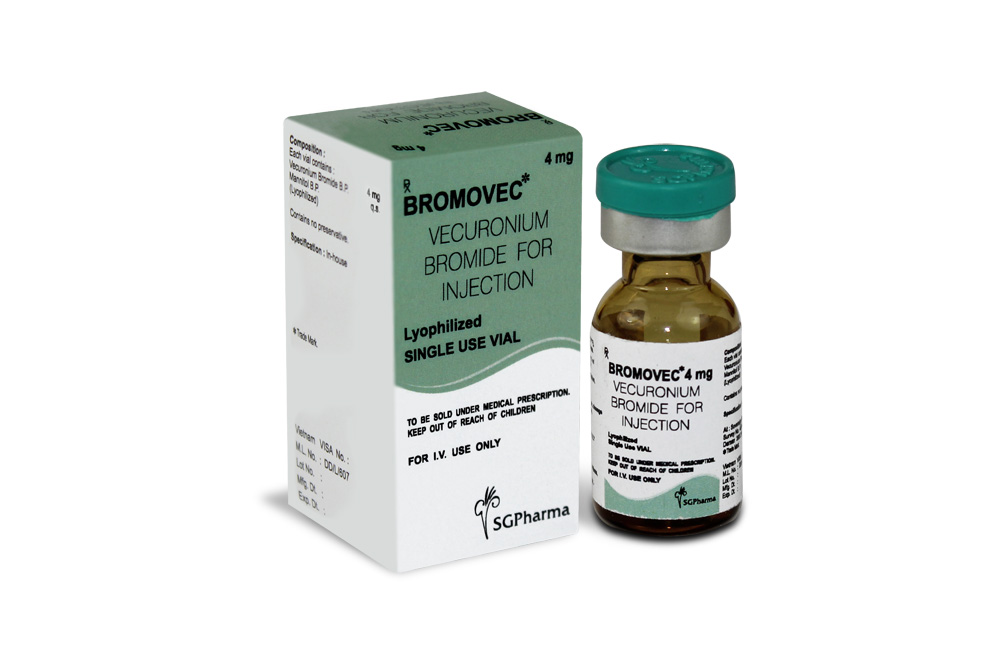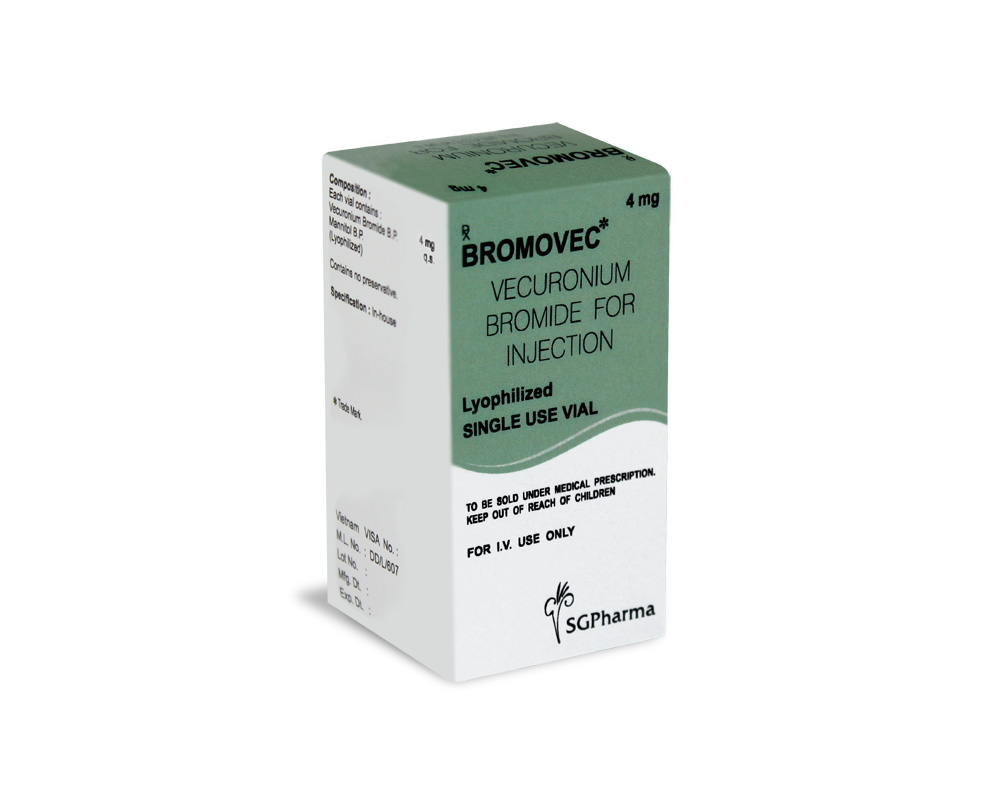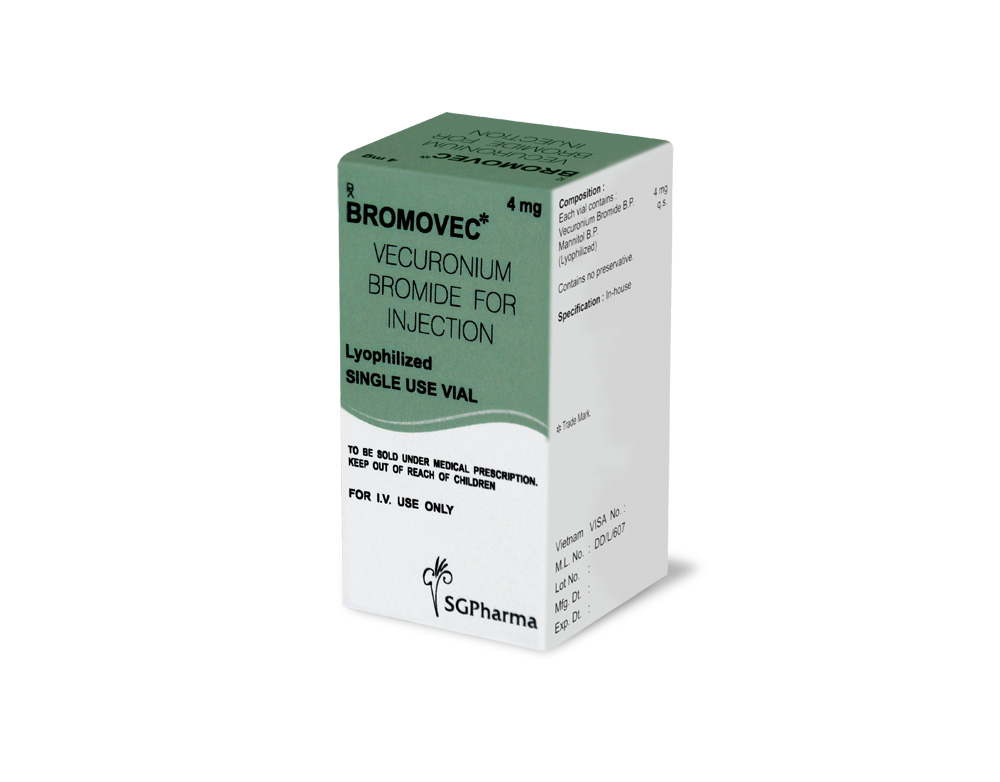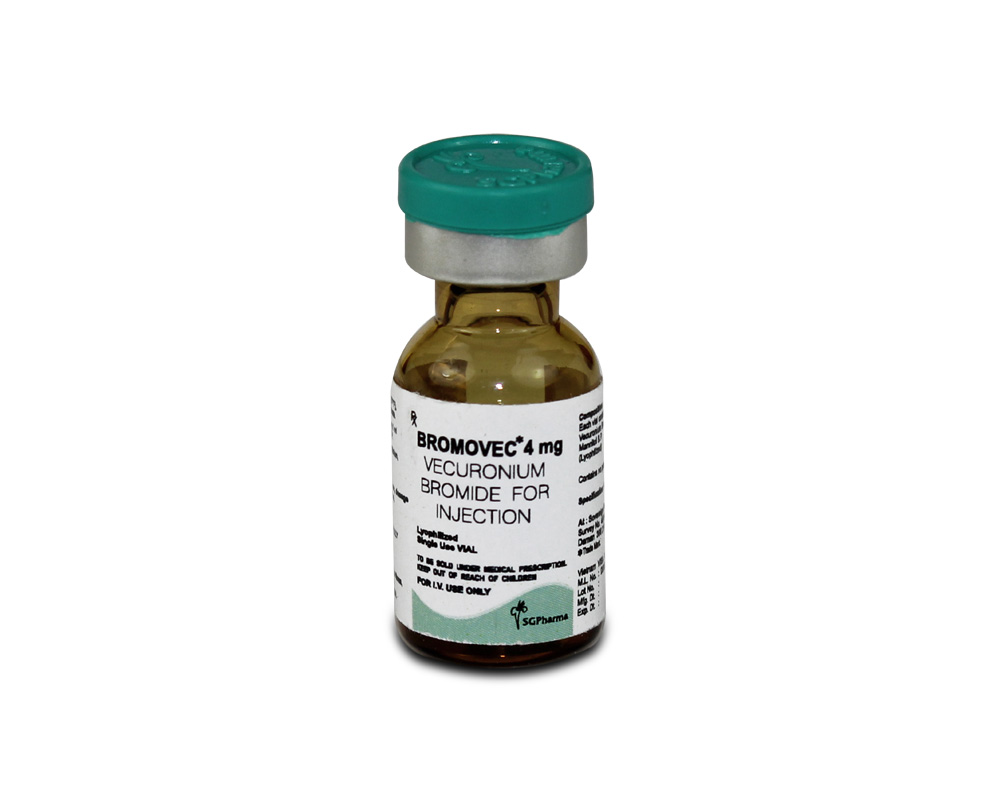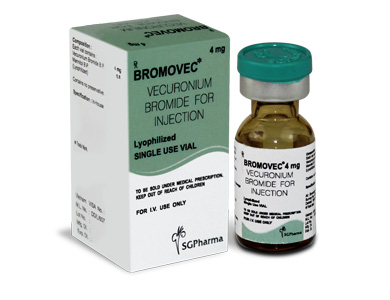
4 mg, 10 mg
For the use of a Registered Medical Practitioner or a Hospital or a Institution only.
BROMOVEC (Vecuronium bromide) is a non-depolarising neuromuscular blocking agent. Chemically, vecuronium bromide is 1-[3,17-Bis(acetyloxy)-2-(piperidin-1-yl)-5-androstan-16-yl]-1-methylpiperidinium bromide. The molecular formula is C34H57BrN2O4 and molecular weight is 638.
STRUCTURAL FORMULA :
Its structural formula is :
-Structure.jpg)
BROMOVEC is supplied as a sterile, nonpyrogenic freeze-dried white to off-white cake in vial of suitable size.
COMPOSITION :
For 4 mg
Each vial contains :
Vecuronium bromide B.P. 4 mg
Mannitol B.P. q.s.
(Lyophilized)
Contains no preservative.
For 10 mg
Each vial contains :
Vecuronium bromide B.P. 10 mg
Mannitol B.P. q.s.
(Lyophilized)
Contains no preservative.
ACTIONS :
Vecuronium bromide blocks the transmission process between the motor nerve-ending and striated muscle by binding competitively with acetylcholine to the nicotinic receptors located in the motor end-plate region of striated muscle.Unlike depolarising neuromuscular blocking agents, such as succinylcholine, vecuronium bromide does not cause muscle fasiculations. Within 90 to 120 seconds following intravenous administration of a dose of 0.08 to 0.10 mg vecuronium bromide per kg body weight (approximately 2 times ED90 under neurolept anaesthesia), good to excellent conditions for endotracheal intubation occur and within 3 to 4 minutes following administration of these dosages, general muscle paralysis adequate for any type of surgery is established. The duration of action to 25 % recovery of control twitch height (clinical duration) with this dose to 20 to 30 minutes. The time to 95 % recovery of control twitch height following this dose is approximately 40 to 50 minutes.
With higher dosages of vecuronium bromide, onset time to maximal block is shortened and duration of action is prolonged. At dosages of 0.15 mg/kg, 0.20 mg/kg, 0.25 mg/kg and 0.30 mg/kg vecuronium bromide, the mean onset time under neurolept anaesthesia were 146, 110, 92 and 77 seconds respectively. The mean clinical duration of action with these dosages is 41, 55, 70 and 86 minutes respectively. With these high dosages, also a gradual, but relatively slight increase of the recovery rate from neuromuscular block occurs.
When vecuronium bromide is administered by continuous intravenous infusion, a steady state neuromuscular blockade of 90 % can be maintained at a constant rate of delivery and without clinically significant prolongation of the recovery time from neuromuscular block at termination of the infusion. Vecuronium bromide has no cumulative effects if maintenance doses are administered at 25 % recovery of control twitch height. Several maintenance doses can therefore be given in succession. The above mentioned properties mean that vecuronium bromide can be used equally as well in short, medium and long lasting surgical procedures. Within the clinical dosage range, vecuronium bromide exerts no vagolytic nor ganglion blocking activity. Administration of acetylcholinesterase inhibitors, such as neostigmine, pyridostigmine or edrophonium, antagonises the action of vecuronium bromide.
PHARMACOKINETICS :
After intravenous administration of vecuronium bromide the distribution half-life is approximately 2.2 (± 1.4) minutes. Vecuronium bromide is mainly distributed in the extracellular fluid compartment. At steady-state, the volume of distribution averages 0.27 l/kg in adult patients. The plasma clearance of vecuronium bromide is 5.2 (± 0.7) ml/kg/min and its plasma elimination half-life averages 71 (± 20) minutes. The extent of metabolism of vecuronium bromide is relatively low. In humans, a 3-OH derivative having approximately 50 % less neuromuscular blocking potency than vecuronium bromide could be demonstrated in the urine and bile. In patients not suffering from renal nor hepatic failure, the plasma concentration of this derivative is below the limit of detection, and does not contribute to the neuromuscular block occurring after administration of vecuronium bromide.
Biliary excretion is the main elimination route. It is estimated that within 24 hours after intravenous administration of vecuronium bromide 40 to 80 % of the dose administered is excreted into the bile as monoquaternary compounds. Approximately 95 % of these monoquaternary compounds are unchanged vecuronium bromide and 5 % is 3-hydroxy vecuronium bromide. Renal elimination is relatively low. The amount of monoquaternary compounds excreted in the urine collected by intravesical catheter for 24 hours following vecuronium bromide administration averages 30 % of the dose administered.
Use in Paediatrics
Neonates and Infants
In neonates and infants the ED90 dose of vecuronium bromide under halothane anaesthesia was found to be approximately the same (approx. 28 mcg/kg body weight) as in adults. The onset time of vecuronium bromide in neonates and infants is considerably shorter as compared to children and adults, probably due to the shorter circulation time and relatively larger cardiac output. Also, a greater sensitivity of the neuromuscular junction to the action of neuromuscular blocking agents in these patients may account for a more rapid onset of action. The duration of action and recovery time with vecuronium bromide is longer in neonates and infants than in adults. Maintenance doses of vecuronium bromide should therefore be less frequently administered.
Children
In children the ED90 dose of vecuronium bromide under halothane anaesthesia was found to be somewhat higher (approx. 32 mcg/kg body weight), although statistically not significant, than in adults. In comparison to adults, the duration of action and recovery time with vecuronium bromide in children are in general approximately 30 % and 20-30 % shorter, respectively. As in adults, cumulative effects with repeat maintenance doses of approximately one quarter of the initial dose, and administered at 25 % recovery of control twitch height, are not observed in paediatric patients. The longer recovery time of vecuronium bromide in neonates and infants is not of a magnitude which would require routine use of reversal agents. If used, these reversal agents are as efficacious for antagonising the neuromuscular block in neonates and infants as they are in children and adults.
INDICATIONS :
BROMOVEC is indicated as an adjunct to general anaesthesia to facilitate endotracheal intubation and to provide skeletal muscle relaxation during surgery.
Administration :
Following reconstitution, vecuronium bromide is intended for intravenous injection or intravenous infusion only.
Reconstitution:
Vecuronium Bromide 4 mg :
Addition of 1 ml Water for Injection results in an isotonic solution of a pH of approximately 4 containing 4 mg vecuronium bromide per ml (4 mg/ml).
Vecuronium Bromide 10 mg :
Addition of 5 ml Water for Injection results in an isotonic solution of a pH of approximately 4 containing 2 mg vecuronium bromide per ml (2 mg/ml).
Any unused product or waster material should be disposed of in accordance with local requirements.
Compatibility:
Alternatively, both 4 mg vials and 10 mg vials of vecuronium bromide powder for injection can be used to prepare a solution with a lower concentration and having a volume of up to 4 ml and 10 ml respectively with the following infusion solutions :
• 5 % glucose solution
• 0.9 % NaCl
• Ringer-lactate solution
• 5 % glucose in Ringer-lactate solution
• 5 % glucose in 0.9 % sodium chloride solution
• Water for injection
If vecuronium bromide is reconstituted with water for injection, the resulting solution can be mixed with the following infusion fluids, packed in PVC or glass, to a dilution up to 40 mg/litre :
• 0.9 % NaCl solution
• 5 % glucose solution
• Ringers solution
• Ringers glucose solution
Compatibility studies with other infusion fluids have not been performed. As is the case for many other agents, incompatibility has been documented for vecuronium bromide when added to thiopentone or thiopentone-containing solutions. Parenteral drug products should be visually inspected for particulate matter and discoloration prior to administration whenever solution and container permit. Except for those solutions with which vecuronium bromide has shown to be compatible, it is not recommended to mix vecuronium bromide with other solutions, or agents in the same syringe or bag. Vecuronium bromide can be injected into the line of a running infusion containing the following medicines: fentanyl, droperidol, nicomorphine hydrochloride and pancuronium bromide.
Dosage :
As with all other neuromuscular blocking agents, the dosage of vecuronium bromide should be individualised in each patient. The anaesthetic method used, the expected duration of surgery, the possible interaction with other medicines that are administered before or during anaesthesia and the condition of the patient should be taken into account when determining the dose. The use of a peripheral nerve stimulator is recommended to monitor neuromuscular blockage and recovery. The following dosages may serve as general guidelines for initial and maintenance intravenous bolus dose requirements of vecuronium bromide to assure appropriate muscle relaxation throughout short, medium and long lasting surgical procedures under balanced anaesthesia, with and without the use of vecuronium bromide for facilitation of endotracheal intubation.
Adults and Children
Intubating dose :
0.08 to 0.10 mg vecuronium bromide per kg body weight, given as an intravenous bolus injection.
Dosages of vecuronium bromide for surgical procedures after intubation with succinylcholine :
0.03 to 0.05 mg vecuronium bromide per kg body weight. If succinylcholine is used for intubation, the administration of vecuronium bromide should be delayed until the patient has clinically recovered from the neuromuscular block induced by succinylcholine.
Maintenance dose :
0.02 to 0.03 mg vecuronium bromide per kg body weight. These maintenance doses should best be given when twitch height has recovered to 25 % of control twitch height.
NOTES :
In obese patients, these doses should be reduced taking into account a lean body mass. Since inhalational anaesthetics potentiate the action of vecuronium bromide , doses of vecuronium bromide in general should be reduced during surgical procedures where these anaesthetics are used. Should there be reason for selection of larger doses in individual patients, initial doses ranging from 0.15 mg up to 0.30 mg vecuronium bromide per kg body weight have been administered during surgery both under halothane and neurolept anaesthesia without adverse cardiovascular effects being noted, as long as ventilation is property maintained. The use of these high dosages of vecuronium bromide pharmacodynamically decreases the onset time and increases the duration of action. In caesarean section and neonatal surgery the dose should not exceed 0.1 mg/kg body weight.
Neonates and infants up to one year of age :
Because of the possible variation of the sensitivity of the neuromuscular junction, especially in neonates (up to 4 weeks) and probably in infants (up to 4 months of age). It is recommended that an initial test dose of 0.01 to 0.02 mg vecuronium bromide per kg body weight followed by incremental doses until 90 to 95 % depression of twitch response is achieved.
Dose requirements in infants of 5 months to 1 year of age are the same as in adults. However, since the onset time of vecuronium bromide in these patients is considerably shorter than in adults and children, the use of high intubating doses in general is not required for early development of good intubating conditions. Since the duration of action and recovery time with vecuronium bromide is longer in neonates and infants than in children and adults, maintenance doses are required less frequently.
Dose requirements for administration of vecuronium bromide by continuous infusion :
If vecuronium bromide is administered by continuous infusion, it is recommended to give a bolus dose first (ED90 or 2 times ED90 dose) and, when neuromuscular block starts to recover, to start administration of vecuronium bromide by infusion. The infusion rate should be adjusted to maintain twitch response at 10 % of control twitch height. In adults, the infusion rate required to maintain neuromuscular block at this level ranges from 0.8 to 1.4 mcg vecuronium bromide/kg/minute. For neonates and infants, see above. Repeat monitoring of neuromuscular block is essential since infusion rate requirements vary from patient to patient and with the anaesthetic method used.
CONTRAINDICATIONS :
Hypersensitivity to vecuronium bromide or to any of the excipients in the product.
WARNINGS AND PRECAUTIONS :
Like other neuromuscular blocking agents, vecuronium bromide should only be administered by, or under supervision of experienced clinicians who are familiar with the action and use of these agents. Since vecuronium bromide causes relaxation of the respiratory muscles, mechanical ventilation until spontaneous respiration is restored, is necessary for patients treated with this medicine.The administration of vecuronium bromide has been associated with rare instances of hypersensitivity reactions (bronchospasm, hypotension and/or tachycardia, sometimes associated with acute urticaria or erythema. Since vecuronium bromide has no cardiovascular effects within the clinical dosage range, it does not attenuate bradycardia that may occur due to the use of some types of anaesthetics and opiates or due to vagal reflexes during surgery. Therefore, reassessment of the use and/or dosage of vagolytic agents such as atropine for premedication or at induction of anaesthesia, may be of value for surgical procedures during which vagal reactions are more likely to occur (e.g. surgical procedures where anaesthetic agents with known vagal stimulatory effects are used e.g. ophthalmic, abdominal or anorectal surgery, etc.).
Presently there are insufficient data to give recommendations for the use of vecuronium bromide in the Intensive Care Unit. As with other muscle relaxants prolonged neuromuscular block following long term use of vecuronium bromide in seriously ill patients in the Intensive Care Unit has been reported. It is essential that during continuous neuromuscular block patients receive adequate analgesia and sedation and that neuromuscular transmission is monitored throughout; furthermore, muscle relaxants should be administered in carefully adjusted doses sufficient for the maintenance of less than complete block by or under the supervision of experienced clinicians who are familiar with its actions and with appropriate neuromuscular monitoring techniques.
The following disease states may influence the pharmacokinetics and/or pharmacodynamics of vecuronium bromide :
Hepatic and/or biliary tract disease :
Experience in patients with cirrhosis or cholestasis has revealed prolonged recovery time in keeping with the role the liver plays in vecuronium bromide metabolism and excretion. Despite the fact that vecuronium bromide is excreted mainly via the bile, in general only moderate changes of the course of neuromuscular block induced by vecuronium bromide are found in patients with hepatic and/or biliary tract diseases. In addition, these changes are dose dependent. With a dose of 0.1 mg vecuronium bromide per kg body weight, a slight, statistically insignificant prolongation of the onset time and decrease of the duration of action were found as compared to normal patients. At doses of 0.15 mg and 0.2 mg vecuronium bromide per kg body weight, the prolongation of the onset time was even less pronounced (0.15 mg/kg) or absent (0.2 mg/kg), and no alterations of the duration of action were found in the 0.15 mg/kg group, while significant increases in the duration of action and in the recovery time were observed in the 0.2 mg/kg group.
Renal failure :
Only limited changes of pharmacodynamic parameters were reported with vecuronium bromide when administered to patients with renal failure. As with other non-depolarising neuromuscular blocking agents, a limited degree of resistance to the action of vecuronium bromide may occur in patients with renal failure. A slight, clinically not relevant, prolongation of onset time and recovery time may occur when vecuronium bromide is administered to patients with renal failure.
Prolonged circulation time :
Conditions associated with prolonged circulation time such as cardiovascular disease, old age, oedematous states resulting in an increased volume of distribution, may contribute to an increase in the onset time of neuromuscular block.
Severe obesity or neuromuscular disease :
Patients with severe obesity or neuromuscular disease may pose airway and/or ventilatory problems requiring special care before, during and after the use of neuromuscular blocking agents such as vecuronium bromide. In obese patients, doses should be reduced taking into account lean body mass. As with other neuromuscular blocking agents, vecuronium bromide should be used with extreme caution in cases of neuromuscular disease or after poliomyelitis since the response to neuromuscular blocking agents may be considerably altered in these patients. The magnitude and direction of this alteration may vary widely. In patients with myasthenia gravis or the myasthenic (Eaton-Lambert) syndrome, small doses of vecuronium bromide may have profound effects and vecuronium bromide should be titrated to the response.
Hypothermia :
In operations under hypothermia, the neuromuscular blocking effect of vecuronium bromide is prolonged.
Conditions which may increase the effects of vecuronium bromide are :
Hypokalaemia (e.g. after severe vomiting, diarrhoea, and diuretic therapy), hypermagnesaemia, hypocalcaemia (after massive transfusion), hypoproteinaemia, dehydration, acidosis, hypercapnoea, cachexia.
Pregnancy : Category C
There are insufficient data on the use of vecuronium bromide during animal or human pregnancy to assess potential harm to the foetus. Vecuronium bromide should be given to a pregnant woman only when the attending physician decides that the benefits outweigh the risks. Investigation in rats (pre-pregnancy up to early gestation and during organogenesis) and on rabbits (during organogenesis) with subpharmacological intravenous doses yielded no indication of embryonic lethality, of growth inhibition of the foetus, or of teratogenic changes.
Nursing mothers :
It is not known whether vecuronium bromide is excreted in human breast milk. Because many drugs are excreted in human milk, caution should be exercised when vecuronium bromide for injection is administered to a nursing woman.
Caesarean section :
The use of VECURONIUM BROMIDE FOR INJECTION in patients undergoing caesarean section has been reported in the literature. Following tracheal intubation with succinylcholine, vecuronium bromide dosages of 0.04 mg/kg (n=11) and 0.06 to 0.08 mg/kg (n=20) were administered. The umbilical venous plasma concentrations were 11 % of maternal concentrations at delivery and mean neonate APGAR scores at five minutes were (9 in both reports. The action of neuromuscular blocking agents may be enhanced by magnesium salts administered for the management of toxaemia of pregnancy.
INTERACTIONS AND INCOMPATIBILITIES :
The following agents have been shown to influence the magnitude and/or duration of action of non-depolarising neuromuscular blocking agents :
Increased Effect
Anaesthetics ; halothane, ether, enflurane, isoflurane, methoxyflurane, cyclopropane. High doses of; thiopentone, methohexitone, ketamine, fentanyl, gammahydroxybutyrate, etomidate, propofol. Other non-depolarising neuromuscualr blocking agents. Prior administration of succinylcholine.
Other Medicines :
Antibiotics : (Aminoglycoside and polypeptide antibiotics, acylaminopenicillin antibiotics, high doses of metronidazole.) Diuretics, β-adrenergic blocking agents, thiamine, MAO inhibiting agents, quinidine, protamine, α-adrenergic blocking agents, magnesium salts.
Decreased Effect
Neostigmine, edrophonium, pyridostigmine, aminopyridine derivatives. Prior chronic administration of corticosteroids, phenytoin, carbamazepine, noradrenaline, azathioprine (only transient and limited effect), theophylline, calcium chloride.
Variable Effect
Depolarising muscle relaxants, e.g. succinylcholine, given after the administration of vecuronium bromide may produce potentiation or attenuation of the neuromuscular blocking effect of vecuronium bromide.
SIDE EFFECTS :
Prolonged Neuromuscular block :
The most frequent adverse reaction to nondepolarizing blocking agents as a class consists of an extension of the drugs pharmacological action beyond the time period needed. This may vary from skeletal muscle weakness to profound and prolonged skeletal muscle paralysis resulting in respiratory insufficiency or apnea.
Anaphylactic and histaminoid reactions :
Anaphylactic reactions :
Although very rare, severe anaphylactic reactions to neuromuscular blocking agents, including BROMOVEC, have been reported. Examples of anaphylactic/anaphylactoid reactions are : bronchospasm, cardiovascular changes (e.g. hypotension, tachycardia, circulatory collapse – shock), and cutaneous changes (e.g. angioedema, urticaria). These reactions have, in some cases, been fatal. Due to the possible severity of these reactions, one should always assume they may occur and take the necessary precautions.
Histamine release and histaminoid reactions :
Since neuromuscular blocking agents are known to be capable of inducing histamine release both locally at the site of injection and systemically, the possible occurrence of itching and erythematous reactions at the site of injection and/or generalised histaminoid (anaphylactoid) reactions should always be taken into consideration when administering these drugs. Experimental studies with intradermal injection of Norcuron have demonstrated that this drug has only a weak capacity for inducing local histamine release. Controlled studies in man failed to demonstrate any significant rise in plasma histamine levels after intravenous administration of Norcuron. Nevertheless, such cases have rarely been reported during large scale use of Norcuron.
Myopathy :
Although very rare, myopathy following prolonged use of muscle relaxants in conjuction with high doses of steroids has been reported in patients in the Intensive Care Unit.
OVERDOSAGE AND TREATMENT OF OVERDOSAGE :
In the event of overdosage and prolonged neuromuscular block, the patient should remain under mechanical ventilation and a cholinesterase inhibitor (e.g. neostigmine, pyridostigmine, edrophonium) in adequate doses should be administered as an antidote. When administration of a cholinesterase inhibiting agent fails to reverse the neuromuscular effects of BROMOVEC, ventilation must be continued until spontaneous breathing is restored. Repeated dosage of a cholinesterase inhibitor can be dangerous.
PHARMACEUTICAL PRECAUTIONS :
Parenteral drug products should be inspected visually for particulate matter and discoloration prior to administration, whenever solution and container permit.
STORAGE :
Store below 25°C (77°F), protected from light.
Do not freeze.
SHELF LIFE :
24 months from the date of manufacture.
PRESENTATION :
BROMOVEC (Vecuronium bromide for injection) is supplied as :
-Table.jpg)
Disclaimer : For the use of a Registered Medical Practitioner or a Hospital or a Institution only. Also it is not intended to be used by healthcare professionals or patients for the purpose of prescribing or administering these products. Questions regarding the complete and current content of product labeling / specification / presentation should be directed to SGPharma.

 Cardiovascular
Cardiovascular



